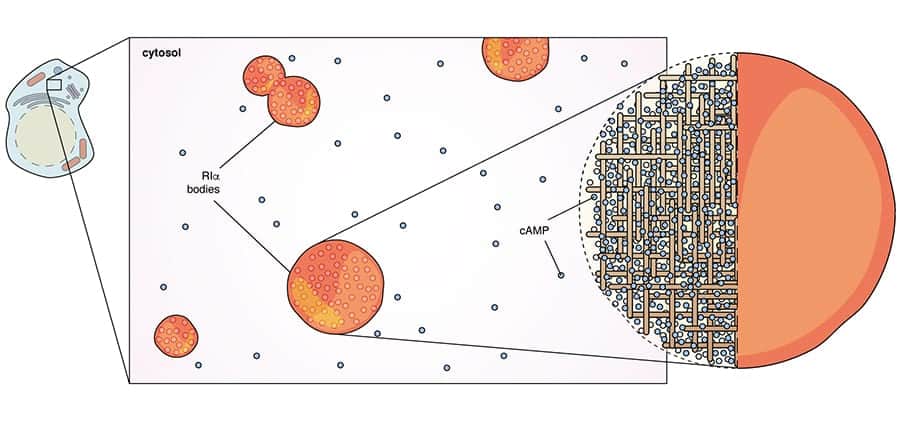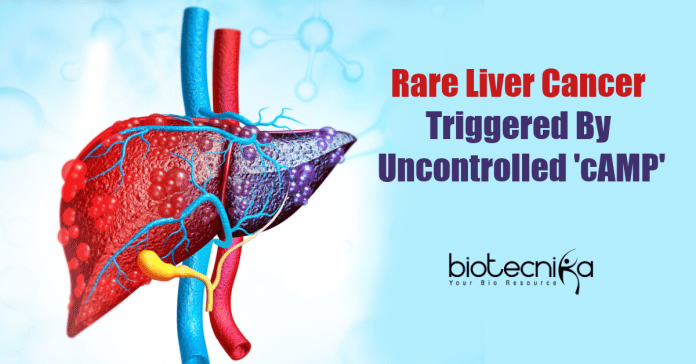Rare Liver Cancer Triggered By Uncontrolled ‘cAMP’
Just like humans first controlled fire and they camped around it to circulate information, indicating each other when something approaches, similarly, certain molecules have been lugging info around our cells to aid regulate bodily functions as required. cyclic AMP or “cAMP” is one such molecule, which probably takes travels freely within cells regulating different activities. In response to ecological changes, it seems to appear in the right place and the right time. It is a mystery that how such a tiny molecule does this. Hence, the scientists at UC San Diego put their heads together to discover more about this.
Fluorescent tools that combine the gene-editing technique CRISPR and biosensor technologies was engineered with a special interest in the implications cAMP presents for human health by Distinguished Professor Susan Taylor and Professor of Pharmacology Jin Zhang, the Department of Chemistry and Biochemistry’s with their team at UC San Diego School of Medicine, With special passion in the effects cAMP offers for human health, the Division of Chemistry and also Biochemistry’s Distinguished Professor Susan Taylor and Professor of Pharmacology Jin Zhang, together with their team at UC San Diego Institution of Medicine, specifically graduate
student Jason Zhang and Assistant Project Scientist Sohum Mehta. These fluorescent probes aided the researchers to look inside cells in an entirely new approach. They observed that an uncontrolled cAMP can trigger a rare type of liver cancer called fibrolamellar carcinoma, or FLC, just like a campfire should be managed to prevent a major blaze. Their results of the study are released in the journal Cell on August 25, 2020.
The researchers clarified that in human cells, cAMP and calcium are two of the most essential second messenger signaling molecules. Generally, binding proteins, kinases, and scaffold proteins that produce signaling molecules’ communities carefully coordinate their sites of action.
Taylor said that they build the long-standing tradition of Roger Tsien, who engineered few of the very first fluorescent probes that allowed us to query events happening in the cell with the exploration of this new non-canonical mechanism for sequestering cAMP. This suggests that the tale of cAMP signaling still has new chapters to study.
The scientist described that the cells are normally organized by membrane-enclosed organelles, these are like “rooms” within a factory where specific functions take place, for example, the mitochondria. It amazed the researchers to uncover that a significant protein that binds to cAMP can form membraneless organelles in cells with a process comparable to how oil beads form in water.
Jin Zhang said that they have additionally discovered that cAMP is dynamically sequestered into these membraneless organelles. cAMP floods the cell, causing unrestrained cell growth– an event that can bring about lump development when these structures are ruined. The outcomes of the study have actually given a long-sought-after solution to the mystery of cAMP.
She added that a lot of people with FLC have an anomaly where an essential cAMP-regulated protein is joined to an unrelated protein. It is not known how hybrid protein specifically leads to cancer, while it is known to drive the formation of FLC tumors.
She claimed that the research revealed – this cancer-causing hybrid protein disrupts cAMP-containing membraneless organelles, enabling cAMP to flood the cell, the uncontrolled cell development is shown by the normal liver cells that have lost their ability to form these cAMP-containing membraneless organelles. This research discovers the mechanism underlying FLC and shows that unrestrained cAMP can result in cancer.
The initial observation under the microscope which surprised the scientists and marked the beginning of their journey to the discovery was these liquid-like structures in cells – seeing just how they coalesced and dissociated, and they added that more surprises were observed.
Jin Zhang said that they were shocked to discover that these membraneless organelles, despite occupying less than 1% of the total volume in a cell, can absorb 99% of the cell’s cAMP. They also observed that the FLC cancer-causing fusion protein fully disrupted cAMP-containing membraneless organelles, which led to the unexpected discovery of a mechanism for its tumor-causing effect.
The group is currently studying the function of these dynamic structures in specialized cell types, as cAMP is essential for each human cell – it is seen in membrane-less organelles in cells of the brain, heart, and pancreas, as per the professor.
She added that the future direction is to look at what else is inside these structures and understanding the rules that allow molecules to enter and stay in these membrane-less organelles, as different membrane-less organelles formed in biological systems have attracted a lot of attention recently, and they are actively looking into the molecular basis whereby uncontrolled cAMP causes cancer.
The research was funded by the National Science Structure, a Taiwan MOE Scholarship, the Airforce Office of Scientific Research, and the National Institutes of Health.
Rare Liver Cancer Triggered By Uncontrolled ‘cAMP’
Author: Sruthi S






























